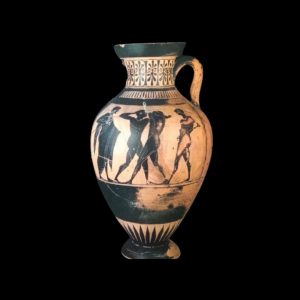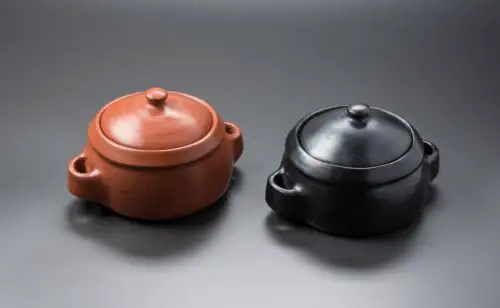Translated by Nick R
A lot has been said about the history of ceramics, particularly given that thousands of inventions have been made over time. However, nowadays a lot is ignored or unknown about all those creations and their meaning in each era.
That is why today, we will share with you 11 of the most representative European pieces existing since the creation of ceramics until recent years. Stay tuned! Read on and discover the history and meaning behind each of these objects.
Table of Contents
1. Pot from Tajos de Cacín
The first piece we would like to reveal today is the Tajos de Cacín pot. It was created in the Neolithic period, approximately between 6000 B.C. and 3000 B.C. in Spain.
The Tajos de Cacín pot was created due to the early development of agriculture and animal domestication and was therefore used to store food or carry liquids from one place to another.
Such functions explain its spherical or ovoidal shape, as the potters of that time tried to imitate the forms of pumpkins and eggshells, which were used for these same tasks.
As this pot was one of the first inventions in the Neolithic, it was handmade and decorated with ancient techniques such as the cardial technique made with sea shells and the combing technique, made with a comb.
This piece is characterized by its spherical shape and by having 3 little grips from which it can be held and transported.

One last thing you need to know about this piece is that, like many others, such as bowls or bone spoons, they have been discovered in caves used by the ancestors as shelters for keeping warm and cooking. This indicates that some groups were already sedentary, abandoning their nomadic lifestyles.
2. The casserole of Ciempozuelos
The Ciempozuelos casserole belongs to the group of campaniform pottery created in the Chalcolithic period between 3000 and 1800 B.C. in Madrid, Spain.
But before we begin to discuss this piece, you must be wondering: what is “campaniform”? – The word “campaniform” refers to an object having a bell-shaped form, that is, like a bell.
Since the potter’s wheel did not yet exist at that time, this piece was also modeled entirely by hand. However, thanks to the experience of the potters, these pieces look better elaborated than those of the Neolithic period. This is reflected mainly in their shape and the fineness of their walls as well as in their finishes.
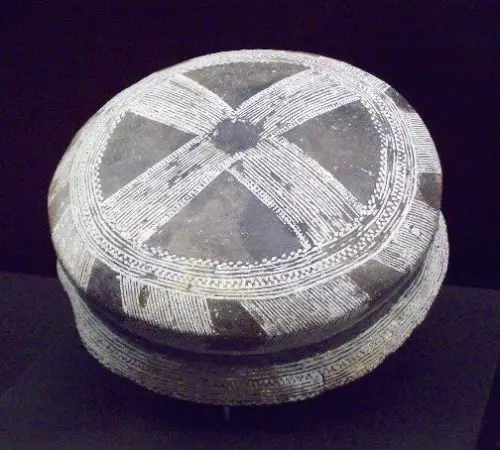
Regarding finishes, the Ciempozuelos casserole characterizes by having metallic finishings achieved through the burnishing technique. Also, we must add that the decoration presented advances, as this item has printed motifs and white lines that provide a striking contrast in the piece.
One question that comes to mind is, what were these pieces used for? The answer may surprise you because, at first glance, the casserole looks perfect for household use, yet its use is far from this field.
Ciempozuelos pots were used as tombs in funerary rituals. However, they were used only by the upper or ruling classes of the time as it was considered luxury ceramic.
Currently, casseroles do not have a specific cultural significance but depict a phenomenon restricted to certain social groups, especially the lower classes.
3. The ceramic vessel
The ceramic vessel is a creation of the second period of the Nagada or Egyptian culture during the pre-dynastic era in the 4th millennium BC. It is worth knowing that this community stood out due to its artistic creativity through which they would tell stories and traditions of their culture.
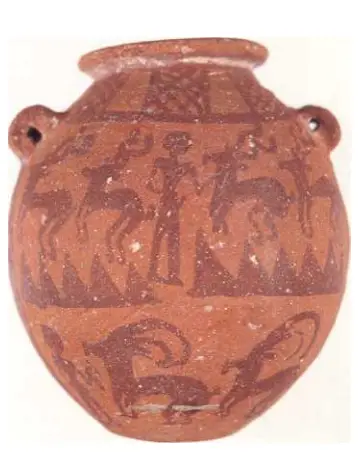
The piece has an ovoidal shape and two lateral handles at the top from where they were regularly held. Its walls are plain and of light color.
In its decoration, the piece contains figures depicting the natural environment and everyday life actions of the Egyptians of that time. Human and animal figures and what appear to be mountains can be observed on it, all painted in a darker tone than the vase.
Other vessels or pieces like plates also feature representations of animal hunting, like lions, and antelopes, among others. Hunting was often depicted because it was part of the subsistence of the Egyptian people.
Thanks to its fine structure and thin walls, it is possible to assume that the potter’s wheel was used in its manufacture, which perfectly coincides with the increase in ceramic manufacture and commercialization during this time.
The ceramic vessel served for domestic use and storing and transporting all kinds of liquids. However, they were also used as funerary vessels in which objects of daily use would be buried.
4. The lady of Ibiza
This piece originated during the Phoenician-Punic colonial period from 750 to 200 B.C. in Ibiza.
From its creation until today, the Lady of Ibiza is considered one of the most significant and representative pieces of Punic art. But what is Punic art? It is simply the historiographical denomination of the art of the Carthaginian civilization, that is to say, from Carthage.
This peculiar piece received several uses. First, the Lady of Ibiza was used as an offering to divinity to ask for fertility, health, healing, and protection. Also, it was buried in funeral rites as a symbol of protection for the deceased, which is why several of them have been found in the cemetery of the Punic ancient capital, Ebusus (Ibiza).

This piece was made of terracotta clay using a mold and then decorated with various techniques. The arms were the first to be added to the body, followed by the necklaces or ornaments that were modeled separately. The tunic, the earrings, and the headdress are decorated with floral figures.
Using a mold for the elaboration of this ceramic figure represents, once again, an advance in ceramic production over time. In addition, it should be noted that the mold allowed to produce other figures and, evidently, caused a surge in the production of these important figures.
5. Kathos or top hat
The Kathos or top hat is the name given to a cylindrical ceramic vase made in the Iberian period from 50 BC to 100 BC in the Archena necropolis (Murcia).
This vase illustrates the enormous progress made by the potters in the manufacture of their pieces. And because of its shape and well-made finishes is evident that they used the potter’s wheel, which represents another advance.
The piece’s decoration is composed of geometric, zoomorphic (animal), and anthropomorphic (human) figures painted over a layer of engobe using brushes of different sizes and thicknesses.
When used for burial rites, the ashes of the deceased were deposited on it; however, for this occasion, the decoration of the Kathos was different and exclusively designed for the ritual.
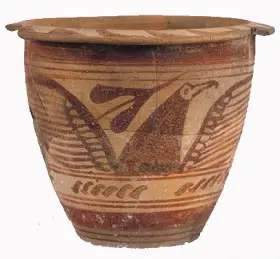
The vessel is decorated with a bird with its wings outstretched, representing a protective goddess of life, death, renewal, and fecundity. It also portrays the protection of the deceased while they transition from earth to heaven. Sometimes the bird could be replaced by a human figure or another bird rising from a flower, both of which have the same meaning.
The top hat was also used for several domestic tasks, including product storage and transport, beverages and food transformation or consumption, and finally, for funerary rituals.
Iberian pottery is original because several Mediterranean peoples, Phoenicians, and Greeks communicated with each other through it. From which many products were born and spread throughout Spain, Italy, North Africa, and the French Midi.
6. The hydria
The hydria is a recipient created to keep and transport water during the Classical Greek period, specifically from 520 to 390 BC.
This piece is characterized by its shape resembling a perfectly turned vase. It has three handles, a vertical one, and two others on the sides. It was decorated with a varnish that took on a particular black color with a peculiar luster after firing.
On the other hand, the figures that could be distinguished in the piece are human figures carrying out certain actions in their daily life, generally women holding hydrias. Although most of the hydrias are dark with light images, there are also light vessels with dark images.
To make these decorations, in the case of the light vessel, only the parts that should be dark were painted to highlight the figures, while in the case of the light ones, the figures were left totally still and then painted around them.
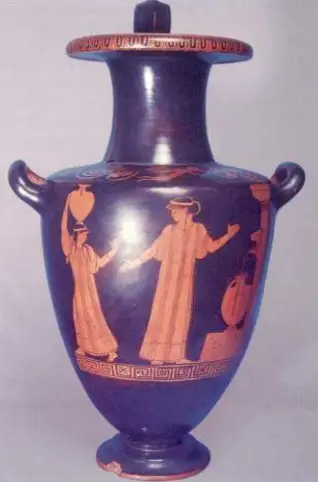
In the image we are showing now, there are two women who seem to be saying goodbye after a conversation while they are filling their water hydrias with water. Eros, the god of sexual attraction and love, appears above them, implying that the conversation had been about these subjects.
Hydrias were successful ceramic objects thanks to their meaning and utility, which allowed them to be produced on large scale and be traded in the Greek peninsula and all over the Mediterranean.
7. The ceramic basin
The seventh item to be discussed is the ceramic basin made during the Roman Empire from the 1st century BC to the 5th century AD.
This ceramic bowl belongs to a style of pottery called “terra sigillata” which translated into English means sealed earth. It is recognized for its red or orange color and its relief decoration.
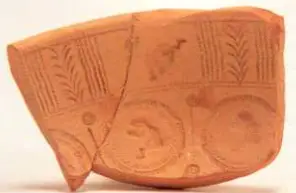
The piece was made in a clay mold with the decoration marked in negative. In other words, the decorative figures in the mold were coated with a substance, such as barbotine, so after painting and firing, it would fall off completely, leaving the drawings imprinted on the piece.
These drawings would remain marked on the piece, which then was coated with a layer of engobe and fired at between 900 ºC and 1,100 ºC. Once the work would come out of the firing, the engobe that had been applied before acquired a bright reddish or orange color, and the clay would get completely hard.
Undoubtedly, its elaboration process was considered one of the most complete and time-consuming. For that reason, the basin became popular, and as a result, its production increased in Italy, so much so that several workshops were set up in various places such as Gaul and Hispania.
In these places, most family men dedicated themselves to this work, accompanied by free wage earners and slaves.
8. The Alhambra vases
Within the Hispano-Muslim ceramics, a group of pieces stands out for their name and appearance: lusterware. However, it is worth mentioning that certain objects stand out from the rest, and these are the Alhambra vases.
The Alhambra vases were created within the Andalusi culture during the Nasrid period in the 14th and 15th centuries. Their name is attributed to the Alhambra palace, where several copies of these vases were found.
The vase was made on a potter’s wheel. Its body is ovoidal in shape and has a high, narrow neck. It also has very different handles, as they are vertical, broad, and do not have a hole for grasping them. These details suggest that it was not intended for everyday use, but instead that its principal function was to decorate rooms.
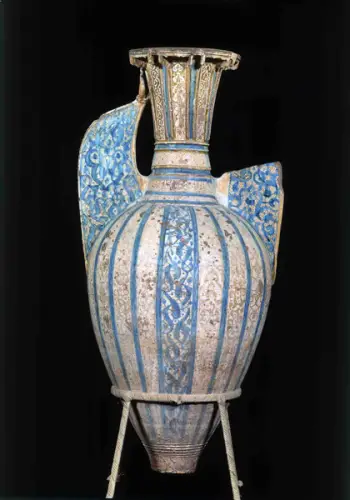
The workpiece is characterized by its blue and gold decoration that mirrors a metallic effect. Moreover, it contains geometric, vegetal, or epigraphic drawings (ancestors’ inscriptions) that provide the vase with distinctive and elegant detail.
In addition, a distinctive and significant aspect of the piece is that the combination of these elements was not intended to imitate elements of nature, as this would be considered an act of impiety towards God.
For this reason, the Muslims began to look for means to produce household objects decorated with blue, white, and gold colors that, like the vase of the Alhambra, gave a metallic reflection. These pieces were called golden earthenware.
The golden earthenware had a great acceptance within the upper social classes, so its production increased and began to be exported throughout Europe.
9. The socarrats
The creation of the socorrats dates back to the 15th century in Paterna (Valencia). The socorrats are a primary element in the evolution of the use of ceramics as they were the beginning of the use of decorative ceramics in architecture.
These pieces were used for two reasons: on the one hand, replacing materials such as straw and wood in constructions to provide better protection and resistance. On the other hand, some decorative motifs of the pieces symbolized home protection.
Wooden molds were used for the manufacture of these pieces. The clay would be placed in the mold, and then it would be dried both when inside the mold and in the air without direct exposure to the sun or humid places. After they were dry, they would be painted black and red with brushes of different sizes, drawing the figures that appear in each socarrat.
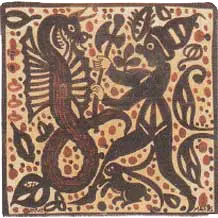
It is worth noting that several of the designs feature traditions of the Christian and Muslim religions. In addition to this, in the background, it is very common to find figures of animals, women, men, flowers, and fantastic creatures, for example, half-human and half-animal.
These pieces became so popular that their production extended to other parts of Spain.
10. Home stoup
In the modern age, during the 16th and 17th centuries, one of the smallest but most significant pieces of the era was born. This object had measures approximately 29 x 19 x 9 cm and received the name “pila benditera” in Spanish.
If you know some Spanish, the name might give you an idea of the meaning and uses that society conferred on this piece. These objects were generally placed in the sacred area of the house: the bedroom. They would be placed next to the head of the bed to provide protection for the person or persons in the room.
Holly water or baptismal water would be kept inside the basin, protecting people from bad energies and negative forces during the nights according to Catholic beliefs.
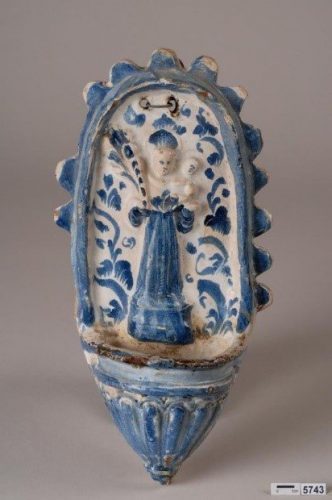
The holme spout is made up of a bowl, which is also called pililla, and just above it, a vertical plate that gives it an elegant and valuable appearance.
So, how was this piece made? Well, first the basin would be made on the lathe, and then the plate by hand. Both pieces were later joined together and decorated with religious motifs.
The use of the holy basin was so recurrent that it became a custom for the believers of the time, so from that moment on, its production increased, and with it, new decorative designs for the piece.
11. El Buen Retiro vase
The Buen Retiro vase had its origin in the Modern Age during the 18th century in Madrid.
This piece was made with firm, white, and translucent paste: porcelain. This type of clay was already being made in China during the 7th century; however, Europeans discovered its elaboration formula in the 18th century and decided to use it to make further stylish, classy, and elegant pieces.
Among their inventions, the one that stood out the most was the Buen Retiro Vase, named after its place of origin, La Real Fábrica del Buen Retiro in Madrid. To make this piece, the ceramists took guidance from classic vases, and for its decoration, they got their inspiration from the art pieces of the French factory of Sèvres.
However, to make them unlike the rest, they adapted a cup-like shape, a lid with a neck form, and the mouth of a typical vase. These objects feature white, brown, gold, and blue colors, and besides this, they usually have images of gods, recognized characters, or significant events that have happened throughout the time.
It is worth mentioning that these vases were acquired by high-class families, as having one of them signified a high social and economic rank.
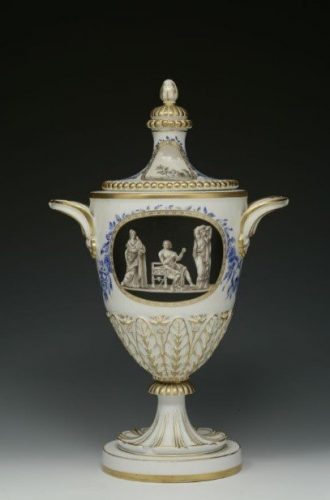
And that’s all for today’s blog. What do you think? We hope you liked knowing which pieces have been the most significant and representative throughout the history of ceramics.
Surely, in a few years, we will continue talking about this topic, and why not, add to the list representative pieces from our generation and those to come. So continue to be part of this fantastic artistic world: maybe in a few years, some of your creations will mark a new stage of ceramics.

